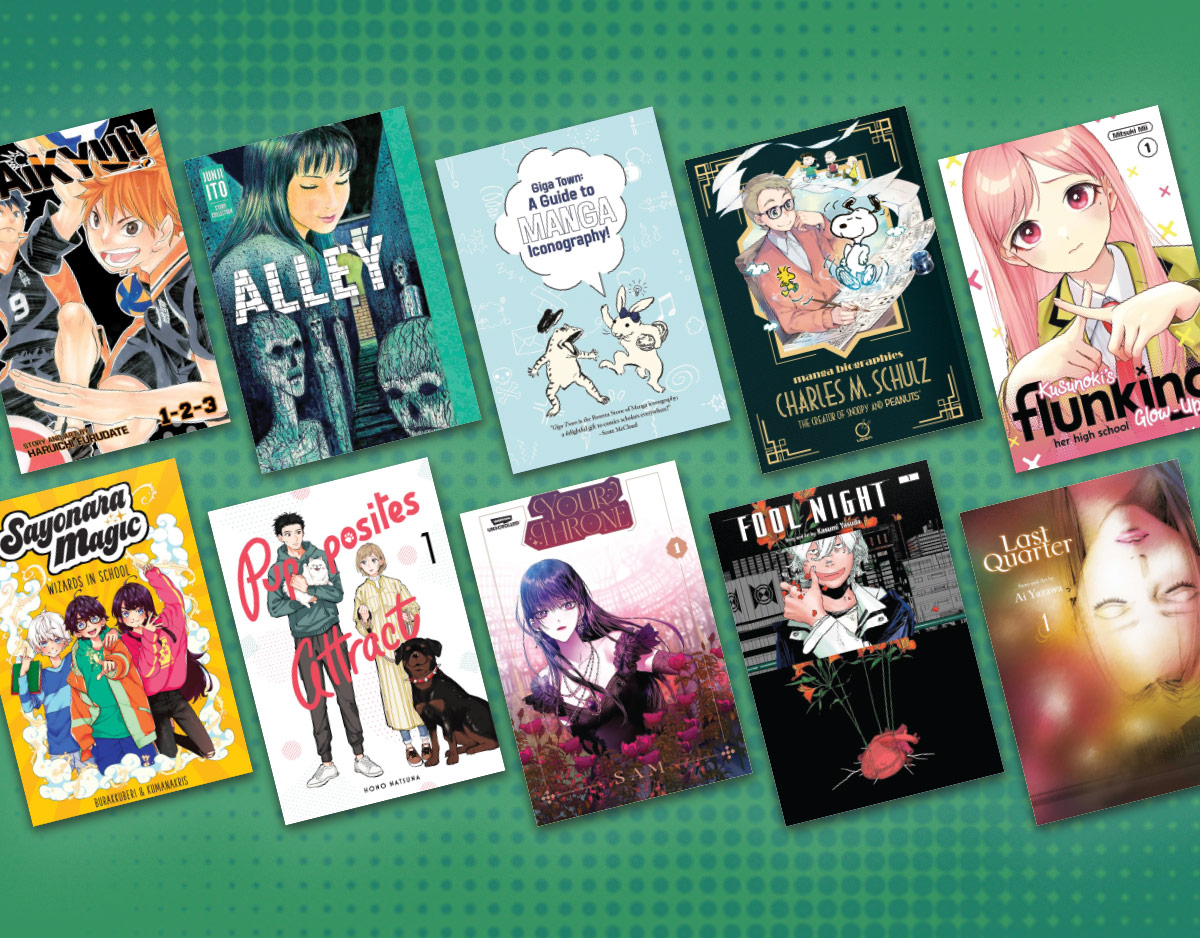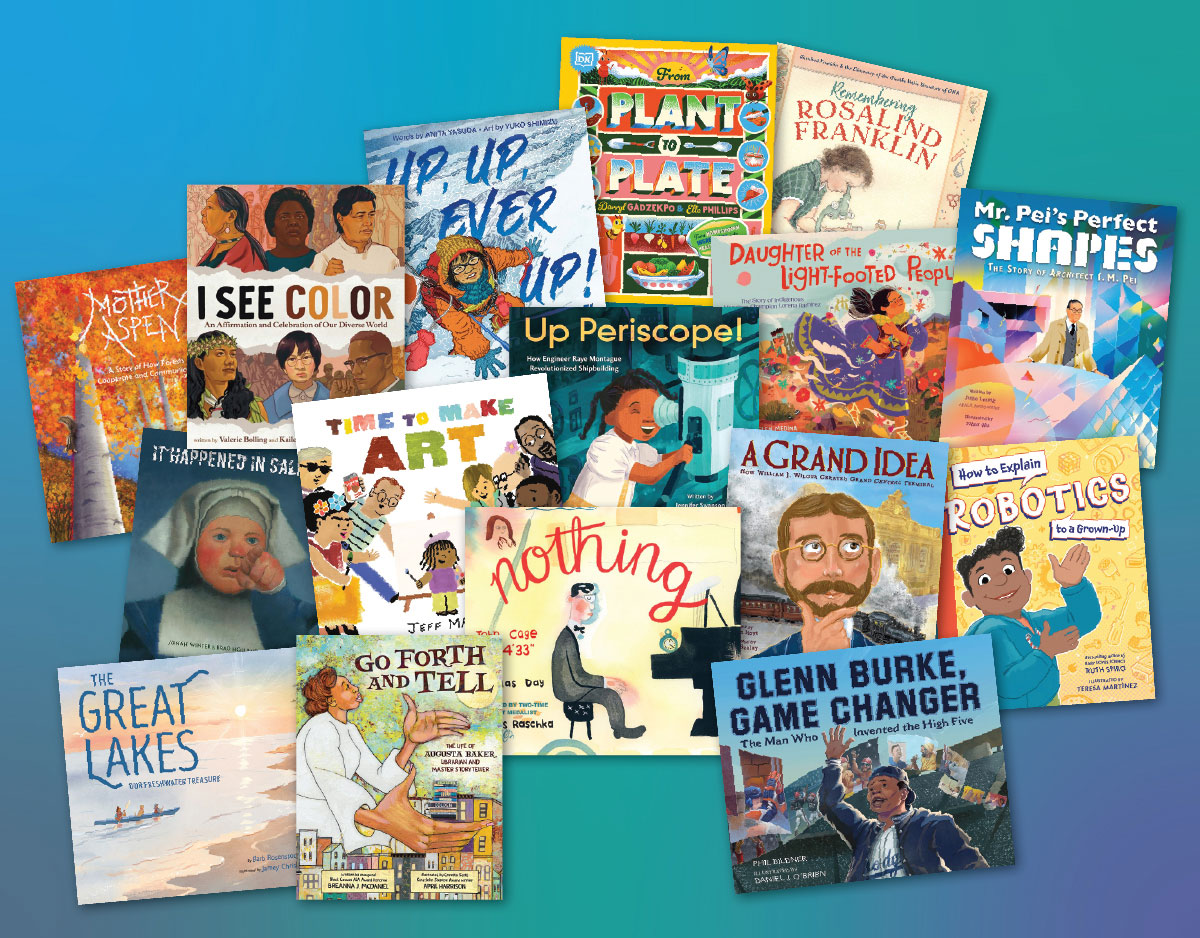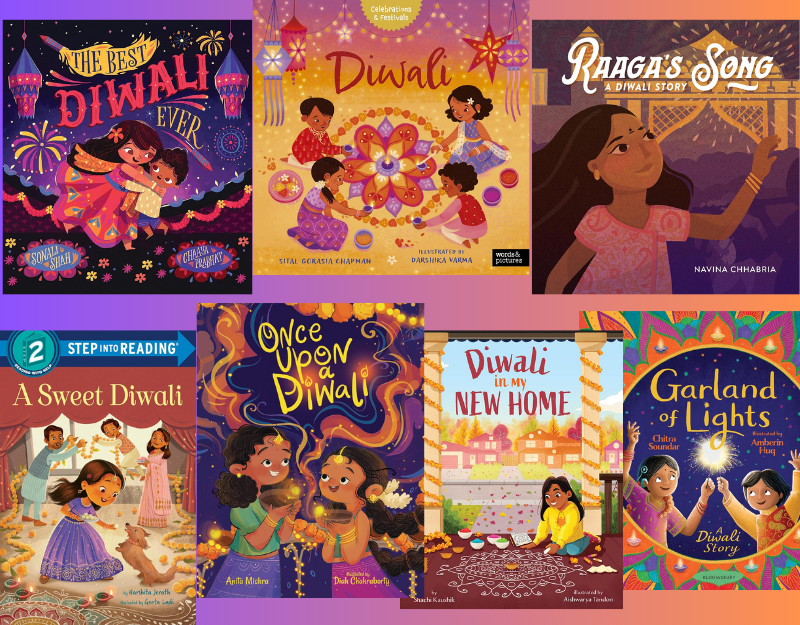31 Days, 31 Lists: 2021 Fairy Folk, and Religious Tales
Back in the day, say 30-40 years ago, this list would be a mile long. It would rival my Translations or Board Books lists in terms of sheer length. Now? Often I feel lucky if any of these books make it to the general market. Too often religious tales belong to small religious presses with their own in-grown distribution. Meanwhile fairytales and folktales are like mushrooms. You have a general sense when they’ll crop up but you never know quite where. Well, folks, they’re cropping up here today and I certainly hope you enjoy them. I did. Each and every last one.
2021 Fairy, Folk, and Religious Tales
Baby Moses in a Basket by Caryn Yacowitz, ill. Julie Downing

You know a picture book’s good when you read it, come back to it later, and can’t remember whether it was based on an old hymn or was an original work. By gum, if some smartie doesn’t set this book to music and pronto, they’ll be missing out on a huge opportunity. This is the story of Baby Moses floating down the Nile and encountering a wide array of different reptiles, birds, and animals along the way. I was charmed by the gentle rhymes and the art that is all at once hyper-realistic and cartoonishly sweet, but what really struck me was the choice of animals Moses encounters. Ibis. Hippo. Crocodile. Each is marvelously rendered. And then that incredibly sweet shot of Pharaoh’s daughter holding the baby to her chest . . . Julie Downing’s outdone herself. If her name sounds familiar you may have seen her work on Linda Sue Park’s The Firekeeper’s Son or Ji-li Jiang’s Lotus & Feather. Pretty much the prettiest baby Moses book I’ve ever cast mine eyes upon.
ADVERTISEMENT
ADVERTISEMENT
Blancaflor, The Hero With Secret Powers: A Folktale from Latin America by Nadja Spiegelman, ill. Sergio García Sánchez

Can true love triumph when you’re dad’s an ogre? Only daughter Blancaflor can defeat his tricks and traps as she aids a young prince on his daring quest. This book works best if you know from the start that the prince is a supreme doofus. I enjoyed that the ogre was at least partially responsible for that doofus’s nature (though the prince definitely reminded me of Jon Hamm’s character on 30 Rock). This story is just jam packed with elements from other tales too. There was a bit of Baba Yaga in there and some Master Maid and a smidgen of Tam Lin. As ever, I adored the front matter info from F. Isabel Campoy as well as the art in the back by the illustrator’s kids. Incredibly fun and original. Feel free to watch me interview the author here:
Boo Stew by Donna L. Washington, ill. Jeffrey Ebbeler
[Previously Seen on the Readaloud List]

Nobody in Toadsuck Swamp can stomach the food Curly Locks dishes up. But when three Scares invade the Mayor’s home, her oddball cooking comes to the rescue. Donna L. Washington is a professional storyteller and with this “fracturing of a well-known tale” she’s given us a truly unique reverse Goldilocks story. Honestly, this reminds me of one of my childhood favorites (Liza Lou and the Yeller Belly Swamp Creature by Mercer Mayer). This book has huge readaloud potential. I love the repetition and the attitude of the whole thing. Kinda pairs well with the middle grade novel Root Magic too. Overall, fun from start to finish.
The Little Blue Bridge by Brenda Maier, ill. Sonia Sánchez

Are any of you out there fairytale fans like me? If so then you might remember the last Maier/Sánchez combination, The Little Red Fort. That clever creation was a feminist retelling of The Little Red Hen story, only with younger sisters rather than barnyard animals. The Little Blue Bridge continues the story of young Ruby and her simply awful brothers, with a retelling of The Three Billy Goats Gruff. Only instead of three goats, it’s three brothers. And instead of a troll, it’s an antisocial kid who guards passage over the creek to the blueberry bushes. He’s an odd kind of bully too. The dog tags he wears around his neck hint at an absent parent and lonely hours. Ruby’s three brothers promise him snacks ala the goats gruff, but the last one of them suggests to the bully that Ruby will provide the feast. Nasty brothers. Ruby, fortunately, solves her problem (crossing the creek) by building a strong and sturdy bridge with the bully’s help. As for the brothers, they are told to go make her a blueberry pie. Bully befriended and pie for everyone. What else could you want? There’s even backmatter covering different types of common bridges AND an Author’s Note that not only discusses the original story (yay, Asbjørnsen!) but also recommends other versions by folks like Pinkney, Galdone, and more. When I do this fairytale list, this is the kind of stuff I love to include.
Living Ghosts & Mischievous Monsters: Chilling American Indian Stories by Dan Sasuweh Jones, ill. by Weshoyot Alvitre

This collection of 32 ghost stories gathered from American Indians across the U.S. will chill your bones and ignite your paranoia. Deliciously eerie and perfect for fans of Schwartz’s Scary Stories to Tell in the Dark this book seriously freaked me out. Now the nice thing about it is that Mr. Jones makes it clear right from the start that he has permission to tell each tale. Indeed, the stories are vetted closely, sourced, and permissions are presented to the reader. Another point that I enjoyed was the fact that while some are old, a lot of these are very recent. There’s a story in here of a mom driving with her two daughters in the backseat that made the hairs on the back of my neck stand up straight. I’d have a hard time choosing which one is my favorite. Maybe the one about the possessed doll? Extra points to Weshoyot Alvitre for the art, by the way. Many is the book of scary stories ruined by not scary art. Not a problem this time.
Osnat and Her Dove: The True Story of the World’s First Female Rabbi by Sigal Samuel, ill. Vali Mintzi

Almost five hundred years ago, Osnat defied tradition and became the world’s first female rabbi. This beautifully illustrated book mixes fact with surreal folk tale touches when telling her story. The “True Story” claim made on the cover is unfortunate but not a game changer for me. And after reading it, I came to the conclusion that the Religious Tales section of this list is where this book truly belongs. I was quite fond of both the art and the storytelling. It’s a colorful and original method of telling a tale with the story set in the 1600s and facts are hard to come by. Stick around for the Author’s Note, which is almost as fascinating as the book itself. There you get to read some of the Osnat stories that Sigal Samuel had to leave out. Altogether, a worthy inclusion. It would pair well with Bruchac’s A Peacemaker for Warring Nations, actually.
A Peacemaker for Warring Nations: The Founding of the Iroquois League by Joseph Bruchac, ill. David Kanietakeron Fadden

This book is a doozy. Honestly, I’m not entirely certain how to approach it. From the cover alone I assumed it was a straightforward history of the Haudenosaunee League, also known as the Iroquois Confederacy. Instead, it’s this sprawling, epic, philosophical consideration of the difficulties of peace and what it costs to bring wars to an end. Bruchac prefaces the whole book by discussing how he owes this telling to the late Chief Jake Tekaronianekwen Swamp and Tom Sakokwenionkwas Porter, particularly Jake’s 1996 audio tape of the Peacemaker’s story called “The Peacemaker’s Journey”. Unfamiliar with the story, I came to this and was surprised to find that I identified with its story, but my lens was Christian. The story itself is about the birth of a child dubbed The Peacemaker who grows up to align the Mohawk, Onondaga, Oneida, Cayuga, and Seneca nations. The art is by David Kanietakeron Fadden, who is an Akwesasne Mohawk artist, and grandson of the founder of the Six Nations Indian Museum in Onchiota, New York. If I can give you a spot of advice about reading it, set aside some time. If you’re reading it to kids, maybe read it over the course of a couple days. It’s the kind of story that you finish and then wonder if it’s really for kids or not. Honestly, a lot of this felt very adult, with its themes of peace and proof, miracles and doubters. You’ll feel as if you’ve been watching a movie by the time you get to the end. Only, it’s a movie where the big climax is a fight that doesn’t happen, rather than does. Entirely one-of-a-kind.
The Robin and the Fir Tree by Hans Christian Andersen, retold by Jason Jameson

I mean, this is Hans Christian Andersen we’re talking about. One way or another, somebody’s going to die in the course of this fairy tale. That’s just his way (except bizarrely in “The Emperor’s New Clothes”, but that’s neither here nor there). Jameson’s version captures that melancholy (even the happy moments are pierced with sadness) but the real standout here is his art. This is like Steampunk Andersen. The bird, the tree, the neck of a stag, they’re all retrofitted with Irish crosses that turn gearlike at times. It’s a gorgeous and confounding style, and inconsistent enough to keep you paying attention. Though it looks like a Christmas story at the outset, don’t fall for it. This would be better served as a circle of life kind of tale. And hey, unlike in “The Happy Prince”, the bird at least gets to live in this one! I call that progress.
Run, Little Chaski! An Inka Trail Adventure by Mariana Llanos, ill. Mariana Ruiz Johnson

ADVERTISEMENT
ADVERTISEMENT
Entrusted with a royal message, Little Chaski longs to be strong, swift, and sharp. But when different animals need help on his route, will he stop to aid them or continue on his way? Okay, I’m on board. Mariana Llanos isn’t interested in defining all the Quechua words she sprinkled throughout the text. The Glossary at the end should be more than enough to help native English speakers figure out the best way to read it aloud (though I recommend you give it a spin on your own before you debut it with a kid or group). And the eye-popping illustrations follow the classic folktale Rule of Threes. There are three qualities Chaski must exhibit and each time he exhibits one of those qualities the text quietly takes note. I enjoyed the explanation of what a chaskis was and the spelling of “Inka” rather than “Inca” is noteworthy. Definitely needs more reads.
Saint Spotting or How to Read a Church by Chris Raschka

There are only a few mainstream Christian authors that can get away with overt religion influencing their works. Shannon Hale. John Hendrix. [And for the record where are all the BIPOC Christian religious authors hiding, hmmm?] Add Chris Raschka to the mix. This book reads like a clever, and surprisingly beautiful, addition. When I was younger I was quite obsessed with books that cataloged every saint, what they represented, where they were from, their life stories, etc. This book is much younger, but it gives a good foundational understanding of some the basics of “saint spotting” in the art of a large church. We all have our favorites (Raschka’s childhood preference for Saint Sebastian probably has a fair amount to do with his easily spotted arrow accoutrements) is both understandable and amusing. Consider this the saint-equivalent of Elise Gravel’s Mushroom Fan Club (an inspired pairing).
The Sea-Ringed World: Sacred Stories of the Americas by María García Esperón, ill. Amanda Mijangos, translated by David Bowles
[Previously Seen On the Translations List]

A compilation of over 50 stories from Indigenous civilizations across the Americas. Be sure to check out the audiobook, since it does a delicious job of going through the individual tales. Sometimes when you encounter a collection of stories you have a hard time following the editor’s organization. In this case, I think Esperón did an expert take on including a few longer stories that dip in-between the shorter tales. I particularly enjoyed the note at the beginning that explains that contemporary listeners may not agree with some of the lessons these stories impart. It’s true, and that’s okay.
The Sister Who Ate Her Brothers: And Other Gruesome Tales by Jen Campbell, ill. Adam de Souza

Dark, disgusting fairy and folktales abound in this global collection of the grisly and grotesque. Took a while but I found a nice, gross folktale book for everyone to enjoy. And man, some of these stories really are repulsive! They aren’t lying. The art from de Souza lightens it a little, but some is just difficult to gloss over. Now Campbell has changed a number of these tales to correct for past and historical inequities, so don’t come to this book for the strict retellings. That said, I really liked Campbell’s attitude towards the differently abled and she even works in a woman marrying a woman, at least once. I am less enamored of the lack of sources at the end. Would have loved at least one bibliography. Ah well. Can’t ask for everything.
Interested in seeing past lists of these titles? Then check these out!
And here’s what else we have happening this month:
December 1 – Great Board Books
December 2 – Board Book Reprints & Adaptations
December 3 – Transcendent Holiday Picture Books
December 4 – Picture Book Readalouds
December 5 – Rhyming Picture Books
December 6 – Funny Picture Books
December 7 – CaldeNotts
December 8 – Picture Book Reprints
December 9 – Math Books for Kids
December 10 – Books with a Message
December 11 – Fabulous Photography
December 12 – Wordless Picture Books
December 13 – Translated Titles
December 14 – Fairy Tales / Folktales / Religious Tales
December 15 – Unconventional Children’s Books
December 16 – Middle Grade Novels
December 17 – Poetry Books
December 18 – Easy Books & Early Chapter Books
December 19 – Older Funny Books
December 20 – Science Fiction Books
December 21 – Fantasy Books
December 22 – Informational Fiction
December 23 – American History
December 24 – Science & Nature Books
December 25 – Autobiographies *NEW TOPIC!*
December 26 – Biographies
December 27 – Nonfiction Books for Older Readers
December 28 – Nonfiction Picture Books
December 29 – Best Audiobooks for Kids
December 30 – Comics & Graphic Novels
December 31 – Picture Books
Filed under: 31 Days 31 Lists, Best Books, Best Books of 2021, Booklists
About Betsy Bird
Betsy Bird is currently the Collection Development Manager of the Evanston Public Library system and a former Materials Specialist for New York Public Library. She has served on Newbery, written for Horn Book, and has done other lovely little things that she'd love to tell you about but that she's sure you'd find more interesting to hear of in person. Her opinions are her own and do not reflect those of EPL, SLJ, or any of the other acronyms you might be able to name. Follow her on Twitter: @fuseeight.
ADVERTISEMENT
ADVERTISEMENT
SLJ Blog Network
One Star Review, Guess Who? (#211)
Kevin McCloskey on ‘Lefty’ | Review and Drawn Response
Notable NON-Newbery Winners: Waiting for Gold?
The Seven Bills That Will Safeguard the Future of School Librarianship
Take Five: Newbery Picks, Part Two
Gayle Forman Visits The Yarn!
ADVERTISEMENT








I included Baby Moses and Osnat in my Tablet article about the best Jewish children’s books of the year: https://www.tabletmag.com/sections/community/articles/best-jewish-childrens-books-2021
Osnat is outstanding. I would be very doubtful that a book this specifically rooted in Jewish religious tradition could win an ALSC award. I would think that even Nicky and Vera, or The People’s Painter, would stand a better, if still small, chance. They reflect modern history and social activism. Of course, Osnat is deeply feminist, but in a different context. But I hope they all find many readers, both Jewish and non-Jewish, even without mainstream awards.